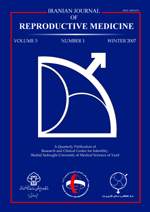
|
International Journal of Reproductive BioMedicine
Research and Clinical Center for Infertility, Shahid Sadoughi University of Medical Sciences of Yazd
ISSN: 1680-6433
EISSN: 1680-6433
Vol. 6, No. 2, 2008, pp. 101-104
|
 Bioline Code: rm08017
Bioline Code: rm08017
Full paper language: English
Document type: Research Article
Document available free of charge
|
|
|
International Journal of Reproductive BioMedicine, Vol. 6, No. 2, 2008, pp. 101-104
| en |
The study of detecting sperm in testis biopsy in men with severe oligospermia and azoospermia by two methods of wet prep cytologic and classic histopathologic
Babolhavaeji, Houshang; Bahar, Seyed Habibollah Mousavi; Anvari, Nahid; Abed, Farhang & Roshanpour, Arash
Abstract
Background:
Many azoospermic patients with non obstructive azoospermia (NOA) are
candidate for testicular sperm extraction (TESE) and in vitro fertilization. Because
sperm might be present in some but not all parts of the testes of such men, multiple
sampling of testicular tissue are usually necessary to increase the probability of sperm
finding. Sperm finding can be done by two methods: 1) classic histopathology and 2)
wet smear.
Objective:
Comparative study of pathology and wet smear methods for discovering
sperm in testis biopsy of azoospermic men.
Materials and Methods:
We prospectively studied 67 consecutive infertile men who
referred to Fatemieh Hospital, Hamedan, Iran between April 2002 and September 2004.
All patients were either azoospermic or severely oligozoospermic. They underwent
intraoperative wet prep cytological examinations of testis biopsy material and
then specimens were permanently fixed for pathologic examination too.
Results:
Among the 67 testes that underwent wet prep cytological examination, 44
(65.7%) were positive and 23 (34.3%) had no sperm in their wet smear. On the
permanent pathologic sections, 19 (28.4%) were positive and 48 (71.6%) cases were
with no sperm in their sections. Among all the individuals 18 (26.8%) were negative in
both studies, while 14 (20.8%) had minimum 1 sperm in their smears in both
examinations. The positive cases in wet prep cytological examination were significantly
more than the cases in the permanent histopathologic sections (p-value=0.000).
Conclusion:
It seems that wet prep cytological examination is more reliable than
permanent histopathologic sections in detecting sperm in testis biopsy of azoospermic
men.
Keywords
TESE, Histopathology, Wet smear.
|
| |
© Copyright 2008 - Iranian Journal of Reproductive Medicine
Alternative site location: http://www.ijrm.ir
|
|
